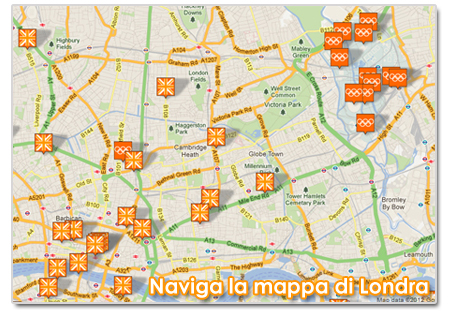Un'onda che emerge dal terreno avvolgendo le piscine. Così appare il complesso natatorio costituito, essenzialmente, da due parti: un esteso podio di calcestruzzo, che contiene tutte le funzioni in un unico volume, e una grande copertura a campata unica, a doppia curvatura, che lo sovrasta; le sue differenti ondulazioni servono a delineare spazi diversi. Il London Aquatics Centre si ispira alle geometrie fluide dell'acqua in movimento, creando spazi interni e forme che si fondono con il paesaggio fluviale del Parco Olimpico. Esso si trova all'ingresso dell'area, a sud-est, e sarà il primo edificio che gran parte dei visitatori incontrerà. La sua forma ricorda un'onda che emerge dal terreno avvolgendo le piscine. L'edificio è organizzato secondo un asse, con andamento nord-sud, ortogonale al ponte pedonale di accesso alla zona, che si integra con esso sovrastando la piscina olimpionica di allenamento posta al piano interrato e diventandone anche la piazza di accesso. Il complesso è costituito, essenzialmente, da due parti: un esteso podio di calcestruzzo, che contiene tutte le funzioni in un unico volume e che diventa un tutt'uno con il ponte e il paesaggio naturale, e una grande copertura a campata unica che lo sovrasta seguendo l'asse principale. Quest'ultima è un elemento a doppia curvatura, la cui forma ricorda una razza, il cui profilo inferiore ha ondulazioni che servono a definire due spazi differenti corrispondenti alle piscine sottostanti (una per le gare olimpioniche, l'altra per i tuffi). Il pragmatismo e la sobrietà che contraddistinguono Londra 2012 hanno portato a ideare un edificio che avrà due vite: attualmente, ha una capienza di 17.500 posti, ottenuta accostando alla struttura principale due grandi e ripide tribune provvisorie che gli conferiscono un aspetto un po' goffo e che verranno rimosse, dopo le Olimpiadi, trasformando l'Aquatics Centre in un luogo a disposizione del quartiere e della città. Sui lati lasciati liberi, compariranno due grandi vetrate a realizzare un centro natatorio immerso nella luce naturale e l'assenza delle tribune svelerà l'elegante e slanciata forma esterna dell'edificio che oggi si può appena intravedere.
A wave emerges from the ground wrapping the swimming pools. This is how the venue appears and it is essentially composed of two parts: an extended concrete podium which contains all the functions in a single volume and a large double curved single span roof; the different curves defines the multiple spaces. The Aquatic Centre is inspired by water's fluid geometries and it creates internal spaces and forms which blends with the river landscape of the Olympic Park. It is located at the south east entrance and it will be the fi rst building that the majority of the visitors will encounter. The shape of the venue reminds that of a wave which emerges from the ground wrapping the pools. The building is arranged along a north-south axis perpendicular to the pedestrian bridge, which allows the entrance to the area and it integrates with the building raising over the Olympic training pool on the lower ground floor and becoming also the entrance square. The complex is essentially composed of two parts: an extended concrete podium which contains all the functions in one single volume which becomes a whole with the bridge and the natural landscape, and one large single span roof above which follows the main axis. The roof is a double curved structure, which reminds the shape of a sting-ray, whose lower profile has waves which defi ne two different spaces which correspond to the swimming pools below (one for Olympic competitions, one for diving). The pragmatism and sobriety characterising London 2012 have lead to create a building which will have two lives: currently it can contain 17,500 seats, this was achieved coupling the main structure with two large and steep temporary stands which make the venue appear a bit clumsy, but that will be removed after the games transforming the Aquatics Centre in a place to be used by the city and by the community. On the sides two large glazed facades will be built to create a swimming centre immersed in the natural light and the absence of the stands will reveal the elegant and slender external shape of the building which today can only be partially seen.
scheda progetto
progetto architettonico/architectural design: Zaha Hadid Architects
committente/client: Olympic Delivery Authority
progetto strutture/structure engineer: Arup (e impianti/and services)
periodo di costruzione/construction period: Giugno/June 2008 - Luglio/July 2011
superficie/area: 42,600 mq
costo/cost: 336 milioni/million euro















